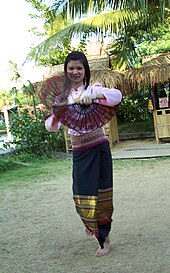Dai (people)
The Dai are one of the 55 officially recognized ethnic minorities in the People's Republic of China .
The Chinese authorities use the term “Dai” ( Chinese Provinz , Pinyin Dǎizú ) to group several Tai peoples in Yunnan Province , although they do not consider each other to be one nationality due to significant linguistic, cultural and historical differences. They are Tai Lü , Tai Daikong or Tai Nüa, Tai Dam , Tai Hongjin , Tai Ya , Tai Daeng and Tai Don . The Chinese government regards the Dai as an independent nationality with a total of 1,261,311 members (2010 census). The Dai live primarily in the Xishuangbanna Autonomous District of the Dai Nationality, the Dehong Autonomous District of the Dai and Jingpo Nationalities, and in the Gengma , Jinggu , Jinping , Menglian , Shuangjiang , Xinping, and Yuanjiang Autonomous Counties .
people
While the Chinese authorities group the Tai peoples living in Yunnan into the Dai group, there are actually several different ethnic groups. Based on linguistic and cultural differences, as well as various historical experiences, the southwestern Tai peoples, which include the ethnic groups that China calls the Dai, can be divided into two subgroups. The border between the two subgroups runs along the Saluen River, i.e. also through Yunnan. While the Tai Lü living east of Saluen traditionally have close ties to the Tai Yuan in northern Thailand and the Tai Khün around Keng Tung in Burma and also to the Lao , the Tai of the Dehong Autonomous District (Tai Nüa) are the Burmese Shan and the Tai - closer to the people of Assam, India .
Tai Dam, Tai Tai Daeng Don and also live in the northwest of Vietnam, where she but with the Phu Thai and other, smaller groups of Nationality of Thái are summarized. The Tai Lü living in Vietnam, on the other hand, are considered an independent nationality. Tai Don, Tai Dam and Tai Daeng also live in Laos, where they come under the category of Lao Thai , while the Lü are again considered an independent ethnic group. In Myanmar, the Tai Nüa and Tai Lü are part of the Shan nationality.
languages
The languages of the Dai belong to the Tai languages (such as Thai , Lao and Zhuang ), a subgroup of the Tai Kadai language family .
The Dai have four different written languages: The most important are Tai Lü (Xishuangbanna-Dai) and Tai Nüa (Dehong-Dai); there is also Tai Pong (Mengding-Dai; especially in Ruili County and in the Gengma Autonomous County of the Dai and Va nationalities) and Tai Dam (especially in Jinping ). As a spoken language, Tai Pong hardly differs from Tai Nüa, but uses a different script, namely the alphabet of the Burmese Shan .
Tai Hongjin , whose dialects differ most linguistically from the other Dai languages (and also from each other), has no written language.
religion
Most of the Dai are Theravada Buddhists .
Calendar system of the Dai
The Dai use their old calendar (Chinese: Daili ) to calculate their traditional festivals . It corresponds to the Thai lunar calendar and the Chula Sakkarat calendar used in large parts of Southeast Asia (Burma, Thailand, Laos, Cambodia) . Accordingly, the year 638 AD is the first year. For example, the year 2007 is then the year 1369. The Dai's New Year usually falls between April 13th and 15th, and in 2007 their New Year's Day fell on April 13th.
See also
literature
- Sara Davis: Premodern Flows in Postmodern China. Globalization and the Sipsongpanna Tais. In: Centering the Margin. Agency And Narrative In Southeast Asian Borderlands. Berghahn Books, 2006, pp. 87-110.
- Volker Grabowsky : The Tai communities in Yunnan and their tribute relations to China. In: Han times. Festschrift for Hans Stumpfeldt on the occasion of his 65th birthday. Harrassowitz Verlag, Wiesbaden 2006, pp. 573-596.
- Mette Halskov Hansen: Lessons in Being Chinese. Minority Education and Ethnic Identity in Southwest China. University of Washington Press, 1999.
- Yos Santasombat: Lak Chang. A Reconstruction of Tai Identity in Daikong . 2nd Edition. ANU Press, Canberra 2008, ISBN 978-1-921536-39-7 .
Individual evidence
- ↑ a b Grabowsky: The communities of the Tai in Yunnan. 2006, pp. 576-577.
- ↑ Yos Santasombat: Lak Chang. A Reconstruction of Tai Identity in Daikong. Pandanus Books, Canberra 2001, p. 2.
- ↑ Yaowen Zhou, Fenghe Fang: The Use and Development of Dai and Its Vernacular writing system. In: Language Policy in the People's Republic of China. Theory and Practice Since 1949. Kluwer, Norwell MA / Dordrecht 2004, p. 202.

